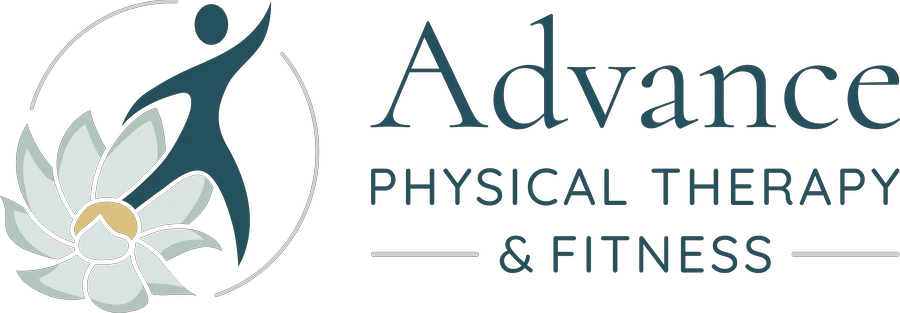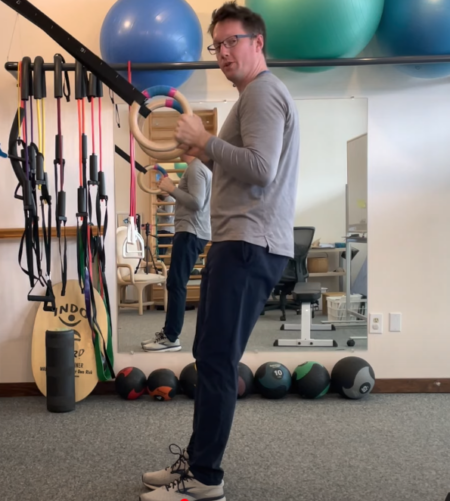Video Library: Squat
Squats are one of the first movements that come to mind when we think of exercising or lifting weights. It’s an extremely useful exercise to gain and maintain strength in your legs. A strong squat will help a lot with getting in and out of a chair. Stairs and curbs become far easier to manage. […]
Video Library: Ring Row
I am big fan of the Ring Row for fitness. It can be done with a TRX, gymnastics rings, pull-up bar, or a fixed barbell. This bodyweight resistance exercise is easily modified for different levels of fitness and physical ability. I describe and demonstrate the Ring Row for fitness here. If you’ve reviewed our previous […]
What does it mean to be “hypermobile”?
If you are hypermobile, you may be “double-jointed” or very flexible. Are you someone able to perform splits easily, put your feet behind your head, or flatten your hands to the floor without bending your knees? If you are an older adult, maybe you were able to perform these movements easily when you were a […]
Telehealth by Physical Therapists?
The worldwide shift in our lives from COVID 19 has quickly made “Telehealth” a household word. You may wonder, how can a physical therapist treat a patient without using their hands? In fact, there are many ways your PT can effectively assess and treat your physical ailments via Telehealth. For physical therapy, we call it […]
What’s bite got to do with it?
At Advance Physical Therapy, you might hear your physical therapist ask you questions about your dental history. “Do you clench or grind your teeth?” or “Do your back molars touch when you bite down?”. At first, these questions might not seem to relate to your musculoskeletal symptoms of neck, back, or hip pain. However, the […]
We’re Hiring PT’s for Adult and Pediatric Spine Care
We are looking for physical therapists with at least 3 years of outpatient experience, manual skills and an interest in knowing more about the Postural Restoration approach. Initiative, Postural Restoration experience and or certification, creativity and a passion for healing are all a plus. We actively support our therapists in the process of Postural Restoration […]
Innovations in Spinal Deformities and Postural Disorders – PUBLISHED!
Innovations in Spinal Deformities and Postural Disorders is now published. For authors: Susan Henning, Lisa Mangino and myself, this was a most welcome notification. Our chapter is titled : “Postural Restoration: A Tri-Planar Asymmetrical Framework for Understanding, Assessing, and Treating Scoliosis and Other Spinal Dysfunctions”. This is the culmination of years of work in developing […]
What is Scoliosis Specific Exercise?
Scoliosis can have many forms. We have general categories for scoliosis and spine curvatures, but each is unique. Scoliosis Specific Exercise are designed to balance scoliosis curves. They address the unique curvatures of each person. Asymmetry is something all scoliosis curves have in common. Asymmetries occur in 3 dimensions: 1) Front to back, 2) Side […]
Spine Fusion Treatment with Postural Restoration
Patients and therapists often feel there is nothing to treat once the spine is fused. They feel it is too late. Patients can feel “stuck” in their fused postures and struggle with bending, turning and walking. Pain may develop in joints that are misused to make up for lost movement after fusion. Patients are often […]
Scoliosis and the Importance of Early Intervention
If you are reading this, there’s a good chance you or your child has scoliosis. I’m going to guess you have a pretty good sense of what scoliosis is. The most frustrating part for you might be trying to figure out what to do about it. Your MD may have said, “Come back in 4-6 […]
The Importance of Arm Swing During Walking and Running
Arm swing is becoming a forgotten part of walking. We live in an era of cell phones, groceries, strollers, large purses and any number of other growing encumbrances. The ability to swing our arms freely is being lost. We forget that as mammals who happen to be up on two legs that our arms continue […]
Chronic Pain in Physical Therapy Students
Our own, Jean Massé, PT, DPT, PRC, OCS, ATC is an adjunct professor at The University of North Carolina in Chapel Hill. She teaches physical therapy students about chronic pain, scoliosis and diagnosis. Over the years of her teaching at UNC Chapel Hill, she has had many students approach her with their own chronic pain […]
Surviving the Gym with Sensory Awareness
Getting to the gym to exercise with the intention of improving fitness and wellness is a great challenge and therefore a great achievement when accomplished. It is, however, beyond disheartening to see people in their chosen exercise routines working really hard at hurting themselves, either with their “trainers” or on their own. Most of us […]
How About My Aching Sacroiliac Joint?
Our bodies are amazingly capable of compensating, allowing us to continue to move and function in our busy lives. Unfortunately, compensation often comes with a cost. The Sacroiliac joint (SI joint) is a common source of compensation and pain when movement elsewhere in the body becomes problematic. The most common issue I see in the […]
Treating Scoliosis Conservatively: Getting the Message Out
Last month, our own Lisa Mangino PT, DPT, PCS, C/NDT, PRC was invited to Fayettville NC to present on “Current Concepts in 3 Dimensional Conservative Management of Scoliosis”. The objectives of the presentation were to help therapists gain an understanding of body imbalances related to scoliosis, to learn about scoliosis measurement tools and x-rays, and […]
What are Curvatures of the Spine?
The human spine is made up of 33 stacked vertebrae. These segments allow small movements in all directions which facilitates balance in the upright position. A normal human spine is not straight. There are small curves at the neck, upper back and low back. If these curves become exaggerated, posture, mobility and stability of the […]
A Physical Therapist Describes Treatment at Advance Physical Therapy
Tell us about your experience at Advance Physical Therapy (APT) and how your function has improved since beginning physical therapy. My reason for coming to APT was to address a mild scoliosis. While not debilitating or the source of intractable pain, it has contributed to severe muscle tension throughout my shoulders and neck, and it […]
67 year old female with a 52 degree lumbar curve due to scoliosis….
The following is a recent testimonial from a patient who traveled from Wilmington to Advance Physical Therapy in Chapel Hill for treatment of scoliosis and kyphosis: I have a smaller thoracic curve and kyphosis as well. I have tried different physical therapists, acupuncture, massage and exercise but nothing worked for the pain I was experiencing […]
Scoliosis and Helping Aging Spines Lengthen
Because our scoliosis approach is quite unique, we often have clients come in from out of town and stay for several days of intensive therapy. On a recent “intensive” situation like this, a patient wrote the following description of her experiences and initial outcome: “I’ve tried so many therapies and treatments for my scoliosis and […]
Tips to Change Habits for Tension Relief
Don’t Be Controlled By Your Focal Vision “Powered Peripheral Vision”, Tips to Change Habits for Tension Relief Adapted from Dr. Heidi Wise, PRI Vision, LLC Focal vision refers to being focused on something small at any distance, from your phone to a golf ball far away on the green. Technology is partly contributing to our […]
The Tremendous Advantage of Early Detection and Treatment of Adolescent Idiopathic Scoliosis
While spinal curvature can develop at any time in a person’s life, there is a tremendous window of opportunity to rehabilitate these changes when it is noticed at a young age, before bony maturity is reached. In fact, idiopathic curvatures most frequently develop during growth spurts, before or during puberty. The etiology or the reason […]
Postural Restoration lends the support our bodies need
Support comes in many forms. I recently completed my certification in Postural Restoration (PRC). I could not have achieved this designation without the support of my co-workers at Advance Physical Therapy, the clients I care for, my family or the faculty at the Postural Restoration Institute. Postural Restoration is an exciting and effective approach to […]
Postural Restoration, the evolution of a new paradigm
As I was returning from another intensive study program, this time, the Postural Restoration Advanced Integration Course in early Dec. 2014, I reflected back, in awe, at the techniques, understandings and tools available to us for maximizing the ability to live balanced, healthy and creative lives in bodies which can move and rest efficiently and […]
Awake Tummy Time: A Crucial Part of Infant Movement Development
It’s always a good time to be reminded about the importance of babies experiencing enough “tummy time” through their early developmental months. As happens with many interventions, the Back-to-Sleep campaign1 to prevent sudden infant death syndrome (SIDS) has produced some unintentional consequences. The campaign was successful in decreasing the occurrence of SIDS; however, parents […]






